Here is an attempt to summarise some of the hive designs available today and explore their benefits and disadvantages. This is a result of my research when deciding upon my own hives. It is by no means exhaustive, and I do not claim to be an expert, but may provide an overview for further reading and researching. This article in particular considers recent understanding about thermoregulation and insulation of hives, as well as natural spatial distribution of comb. It also considers various philosophies of beekeeping, perhaps a key factor to improve our stewardship of the environment within the context of the climate crisis.
Categories
Instead of merely listing the various hive designs, I have categorised them into framed or unframed, with sub-classfications as below. In addition, there are several related aspects which do not neatly fit into these categories such as the presence of insulation and the positioning of the hives.
- Framed
- Vertical
- National
- WBC
- Langstroth
- AZ hive
- Horizontal
- Shallow frames: long hive
- Medium frames
- Deep to extra deep frames: Layens, Einraumbeute, Lazutin, ZEST, Trågkupa
- Vertical
- Unframed
- Vertical
- Warre
- Log hives, freedom hives, Ruche Sauvage
- Skeps
- Horizontal
- Kenyan and Tanzanian top bar hives
- Cathedral hive
- Bienenkiste
- Diagonal
- Diagonal cathedral
- Vertical
Framed hives
Frames are based on the principle of bee space. This refers to a spacing of about 7-9mm each side of the frames in which bees tend not to fill with comb or propolis. Rev Langstroth is credited with discovery of the bee space in the 1800s (although previous researchers had recognised it). This revolutionised apiculture by allowing the beekeeper to manipulate the frames relatively easily without excessive disruption to the comb structure.
Framed hives can be further classified into vertical and horizontal hives.
Framed – Vertical hives
These are the mostly commonly used hives in the world, particularly amongst commercial beekeepers. They include the UK National hive, WBC and Langstroth hive.
National hive

The National hive is the most commonly used hive in the UK. It consists of square boxes in which a number of frames sit. Boxes are stacked on top of each other (supered) as the season progresses, normally with the use of a queen excluder to confine the brood to the bottom of the stack. Normally made out of 25mm cedar or similar softwood, it affords some degree of insulation, although many beekeepers choose to also wrap their hives during winter to increase insulation.
Advatages:
- Low cost, easily available, easy to sell
- Easy to find mentors
- Easy to manipulate for inspections and harvesting
- Standard measurements mean easily interchangeable parts and compatible with commercially available centrifugal extractors
Disadvantages:
- Suboptimal insulation
- Tall hives are unstable in strong winds and require anchoring
- Lifting a box which is full of capped honey may be difficult for shorter or smaller people
- Storage is needed for components not in use
- The use of queen excluders may be considered unphysiological
WBC hive
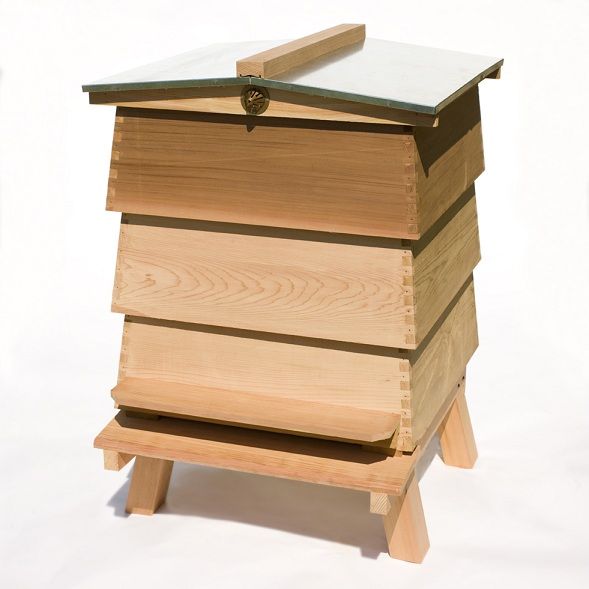
The William Broughton Carr (WBC) hive is basically a National hive with an outer shell to afford more insulation between the hive and the outer sloped sections.
Langstroth
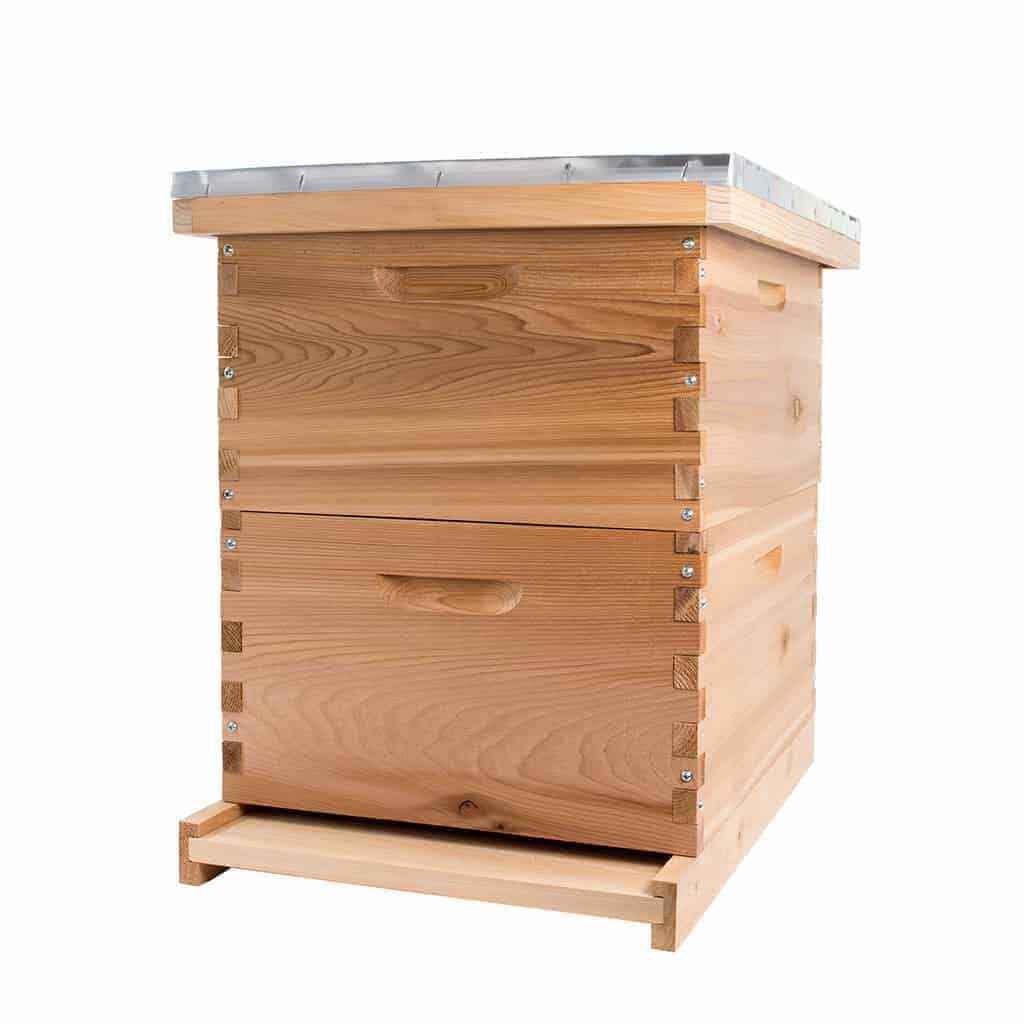
The Langstroth hive is the most commonly used hive in the USA. It is very similar to the UK national hive, but the frames are of a different dimension. As such all these carry similar advantages and disadvantages.
AZ Hive
The Slovenian AZ hive is essentially a vertically-oriented, framed hive with a rear opening. It is commonly used in large commercial operations as part of “bee houses”, where many AZ hives are stacked into the wall of a shed, allowing the beekeeper to work in shelter. Queen excluders are often used and some of the issues regarding drift are mitigated by painting each hive in different colours. However, when used in such a fashion, it dramatically increases the density of honeybees in an area, which affects the populations of other flying pollinators. The risk of drift may also increase the risk of disease transmission.
Images from: https://www.mybeeline.co/en/p/whats-the-buzz-about-slovenian-az-beehive and https://www.modernbeekeeping.co.uk/az-hives/az-hive
Framed – Horizontal hives
The horizontal long hive is gaining popularity amongst hobbyist beekeepers. Different horizontal hives make use of different dimensions of frames. In the UK, many of these continue to use of British Standard (BS) frames, which make them interchangeable with national hives. But there are many other options too.
The horizontal hive includes several subtypes and eponymous hive designs built around the BS frame. Here, I have divided them based on frame size.
Shallow frames
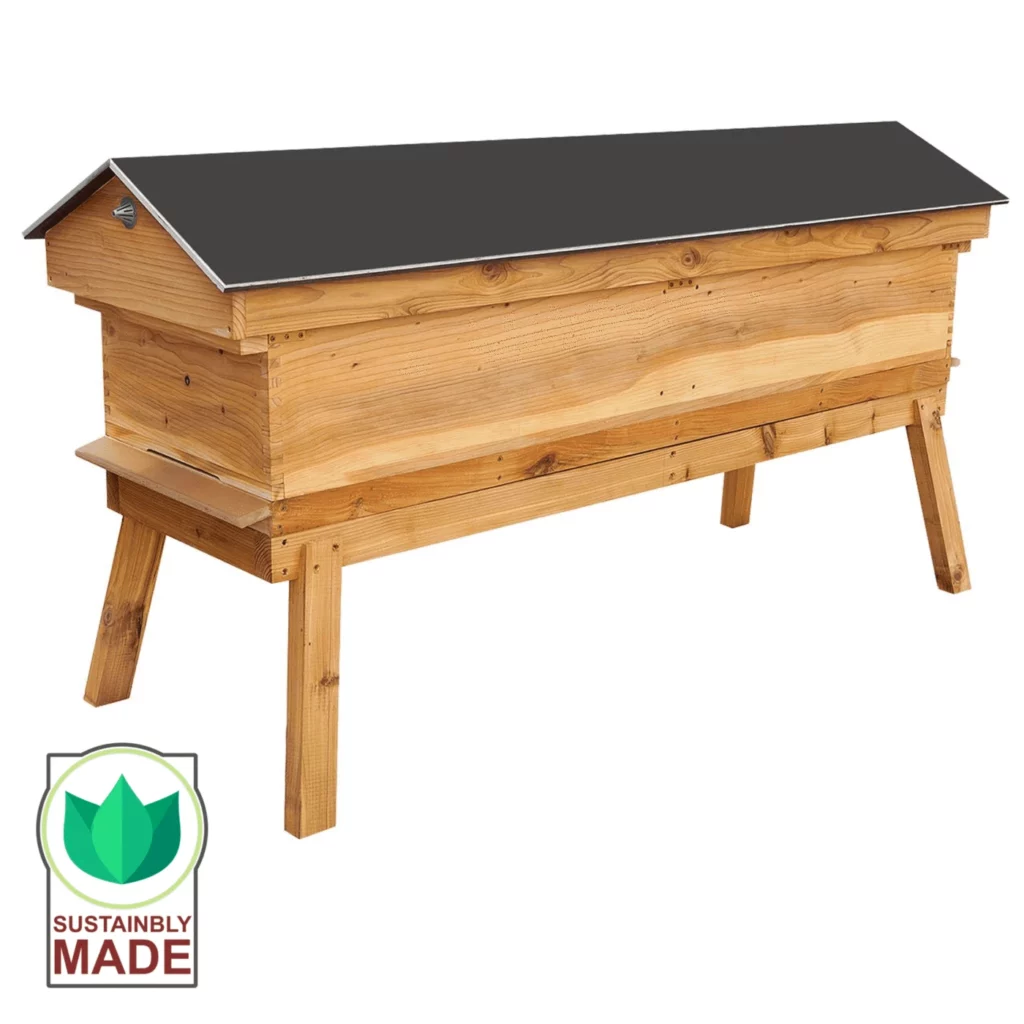
National horizontal long hives are essentially like national boxes fitted alongside one another rather than stacked. The hive is opened from the top and the frames can be inspected the same way as a national hive. Queen excluders can be used and feeders can be placed above the crown board.
Advantages
- No heavy lifting of boxes
- Ability to interchange between other national hives and frames
- Ease of inspection and availability of compatible parts
- Could potentially house more than one colony in a hive. This can also facilitate artificial swarms
- Generally allows for a continuous brood nest (with exceptions)
- If used with extra deep frames, provides near physiological spatial distribution of comb
Disadvantages
- Tend to be expensive to purchase
- Non-standard extractors which may be difficut to obtain. May therefore be confined to crush and strain (which in itself has both benefits and disadvantages)
- The hive itself is heavy and once in position will be very difficult to move
- Might be more difficult to locate a mentor with experience
- Frames still generally dictate the overall architecture of comb
Medium frames
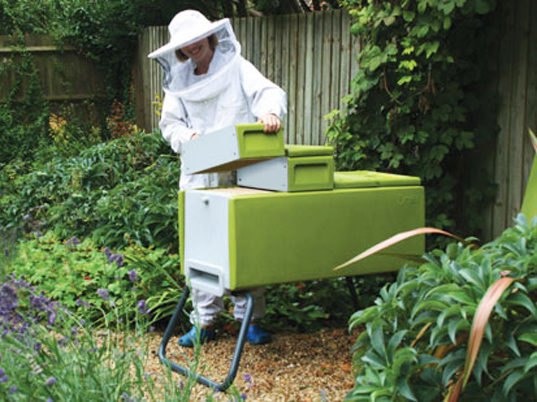
These include the British 14×12 frames. The advantages and disadvantages are similar to above. However, the slightly deeper frame arguably allows for better spatial distribution of brood and supplies on the comb. The Dartington hive and the Omlet Beehaus are both examples. Both have additional advantages of allowing national boxes to be supered, which facilitates queen excluders and ease of harvesting. Some have mesh floors and inspection boards for traditional varroa control methods.
Dartington hive: http://www.eastdevonbk.co.uk/?page_id=368
Beehaus: https://www.omlet.co.uk/shop/beekeeping/beehaus/
Deep to Extra deep frames
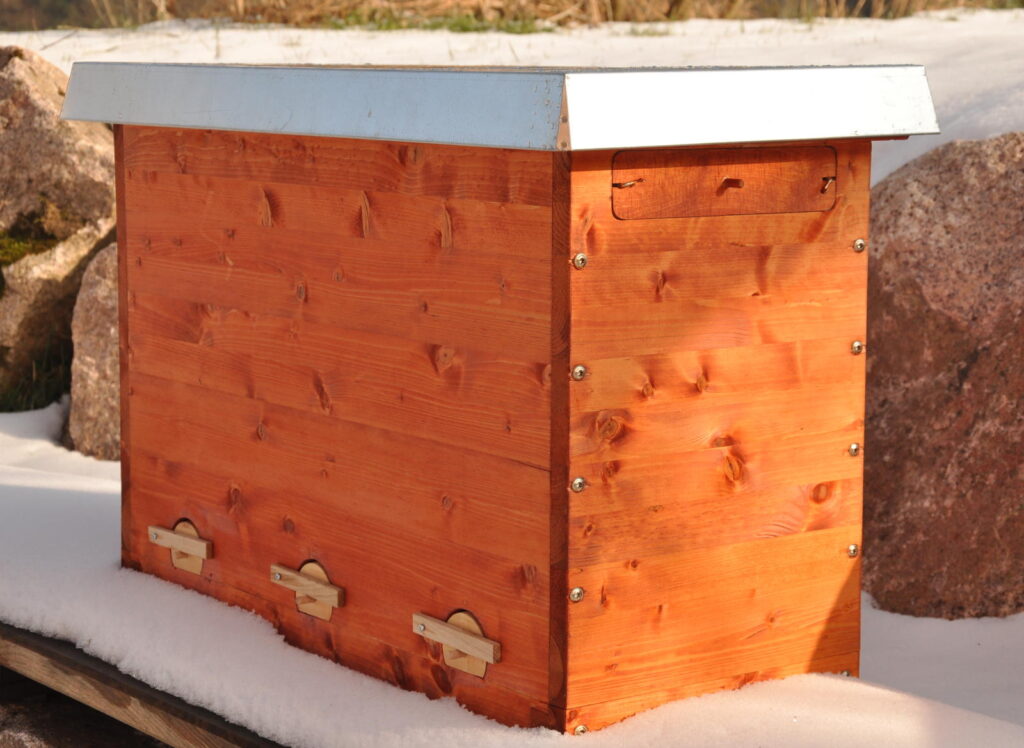
The premise of deep and extra deep frames is an attempt to mimic the spatial distribution of brood found in wild colonies. If allowed, bees tend to built comb downwards, arranging their brood towards the bottom or middle, surrounded by pollen, and finally surrounded by honey stores. This target-shaped spatial distribution theoretically allows natural movement of the winter cluster of bees upwards as they consume their honey stores, without the need to cross to an adjacent comb. It is a highly efficient distribution of supplies.
Horizontal hives with extra deep frames include the Layens, Lazutin, Einraumbeute (ERB)(also known as the golden hive) and ZEST hive. They vary in terms of the frame dimensions. ERBs are slimmer but deeper (285 x 460mm), while Layens are wider but shallower (365 x 400mm). The Lazutin is significantly bigger than both (425 x 422mm). The ZEST hive makes use of existing frame formats such as deep national and multiple langstroths. Because of their size, they are confined to the horizontal format.
The original ERB does not have additional insulation, while the Layens exists in both insulated and solid styles. The Lazutin hive includes an additional layer of insulation between the inner and outer walls.
The ZEST hive uses aerated concrete blocks to create thick walls which are light but with high insulative properties. It exists not as a single unit, but as multiple blocks stacked. As such, it cannot be moved easily. Instead of wooden frames, it makes use of plastic frames. These are propolised less by the bees, making it easier to handle, but potentially reduces colony immunity as a side effect. I do not know of comparisons between wood and plastic in terms of absorption of micro-toxins over time. Queen excluders are frequently used, unlike in Layens, ERB and Lazutin. While this may make honey harvesting easier, it limits physiological comb distribution. Supers may also be used with queen excluders. Again this increases ease of honey harvesting, but may be unphysiological. This needs deeper considerations when intepreted in light of some experiments by Torben Schiffer. He showed that colonies which failed to build comb at the top of hives perished. If this is an evolutionary drive, then it may suggest that adding supers taps on this drive. But while they may rush to fill the gap due to evolutionary instincts, it may also inadvertantly cause a large collective stress response, akin to an organisational crisis.
I have 3 modified ERB hives which I built. They have several modifications borrowed from other hives. Firstly, all are insulated with between 25-50mm of wool. The inner and outer walls are made with wood of varying thickness (9-25mm). They contain a bottom void and a hatch for maintenance. This was recommended by Leo Sharashkin. In addition, I have followed David Heaf’s addition of Warre-style quilts above the box. My experience with building these hives will form a separate post.
Einraumbeute: https://www.mellifera.de/
Layens: https://horizontalhive.com/
Lazutin: https://lazutinhives.com/
ZEST hive: https://www.thezesthive.com/
The Swedish Trågkupa is a versatile hybrid of several styles. It is essentially a deep and large trough hive which can make use of a variety of frames. From my reading, it seems to be used with queen excluders and supers, which as discussed may be unphysiological to comb and brood distribution.
Unframed hives
In the wild, bees do not build their combs in a linear fashion. This underpins the principles of unframed hives. Since we do not fully understand the effects of air flow, convection and spatial distribution of brood, the overall philosophy supports the colony’s own decisions in organising their comb and hive. As a result, one may consider it more physiological for the colony. However, this makes inspection and manipulation of comb difficult at best, and sometimes impossible. This is not to say that it is not congruent with modern apiculture practices. In fact, there are emerging philosophies which aim to provide the most physiological environments for bees to thrive.
Vertical unframed hives
Skep
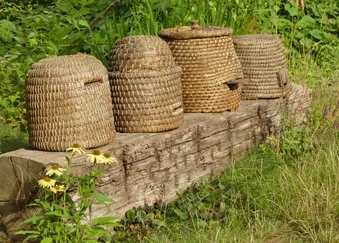
The traditional skep was used for centuries before both the development of frames, and the popularity of wood for beehives. The skep is essentially an elongated hemisphere woven with straw. Sitting upside down on a stand, it contains a small opening which acts as an entrance on the wide bottom end (equator), and a closed vertex. Bees (obtained as a caught swarm) would build their comb from the inner surface of the vertex downwards to the equator. Traditionally, for harvesting, the colony would be killed prior to the end of the nectar flow season. Skeps are still used these days, but the colonies are not killed. There are several advantages of skeps. These include:
Advantages
- Natural comb structure and hive architecture
- Woven straw contains many gaps and air pockets. This encourages propolisation.
- Small volume which encourages swarming (this allows for a natural brood break and minimises brood diseases including varroa. Of course swarming could be interpreted as a disadvantage too)
Disadvantages
- Poor thermal performance
- Unable to carry out inspections
- Modest harvest which is also messy and difficult to perform
There are modern hybrids of the skep like the Sun hive. This is essentially two skeps with semi-circular top bars to allow for some inspection. The teardrop shape allows for a physiological comb building (although arguably the top bars discourage it). Some versions include a clay outer layer which provides good thermal insulation.
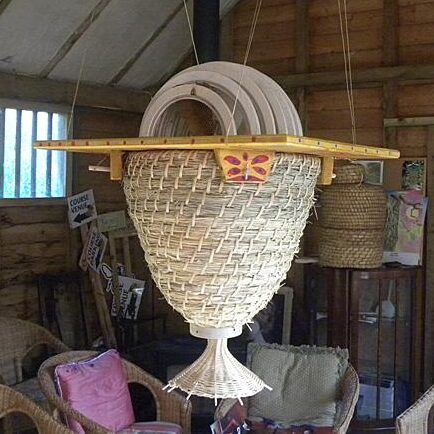
Warre hive
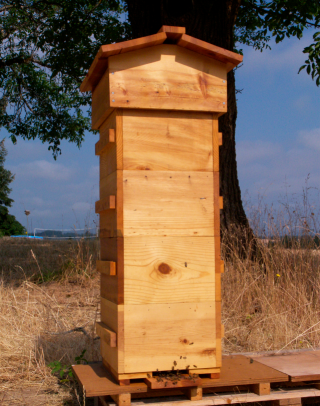
The Warre hive is another popular style. It was invented by the French Monk Émile Warré, after surveying and testing over 300 hive designs. It resembles a National hive, and indeed consists of square boxes stacked on top of each other. However, there are no frames. Instead top bars are used to provide an initial guide for bees to build comb. Instead of supering (placing additional boxes on the top of existing boxes), additional boxes are nadired or placed underneath existing boxes. This is based on the fact that bees build their comb downwards and so this practice could be considered more physiological. While the original Warre hive does not include insulated walls, it does include a quilt at the top of the stack. This quilt is essentially a tray filled with straw or wood shavings. It acts as a moisture absorber and provides a modest degree of thermal insulation. The roof also has ventilation holes to allow moist convection currents to escape.
Advantages
- Physiological comb building downwards
- Small footprint
- Sizeable community of users
Disadvantages
- Nadiring requires heavy-lifting so may not be suitable for everyone
- May require additional insulation
- Bees may not build according to tap bar guides. This makes inspection difficult
- Extraction of honey cannot be done via centrifugal force (but crush and strain could be considered an advantage due to the high pollen content)
Log hive
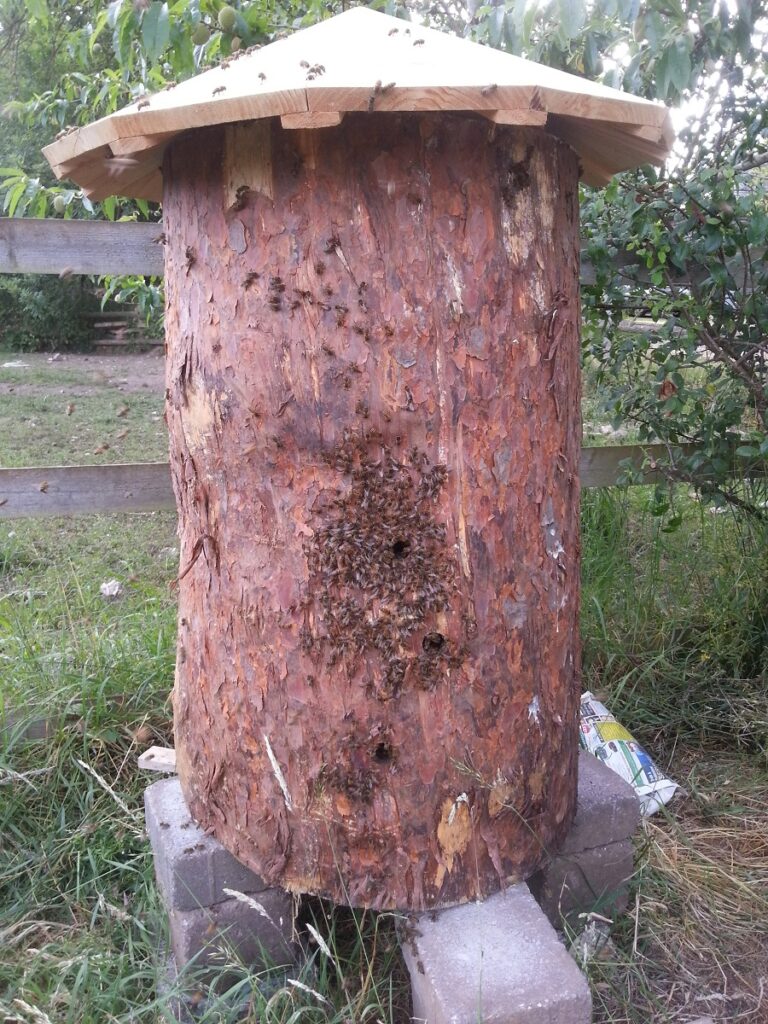
Log hives and their hybrids attempt to mimic the natural environment of bees as much as possible. In the wild, bees tend to build hives in the hollows of trees. There are theories that living trees provide some environmental feedback which promotes health of the bee colony. That may certainly be the case, and before the inventions of skeps and beehives, tree beekeepers would capitalise on these wild colonies. They would create access sections on the tree trunk which would allow them access to the combs they would harvest. The bees would not be harmed. Most of these colonies would live high in the trees, so managing these hives can be dangerous. There are still tree beekeepers in Russia and Central Asia, and a small number who practice the art all around the world.
Back to log hives. These differ from tree hives in that the wood in log hives is dead, compared to a living tree. They are hollowed out using a gouge or chainsaw. One or more entrances are created and they are either positioned horizontally or vertically in a stationary spot (usually on the ground). A cover ensures some rain protection (if vertical) and protection from other creatures and elements (if horizontal). These are then either populated via transfer of a swarm, or directly from a visiting swarm. Log hives provide a natural environment for bees and possibly mimics their natural environment as much as possible.
Advantages
- Natural cavity. Will contain natural microorganisms which may have beneficial or symbiotic relationships with bees.
- Rough surfaces encourage propolisation, which in turn bolsters colony immunity and protection
- Thick walls ensure good insulation and minimises temperature fluctuations
- Small entrances make it easy to guard
Disadvantages
- Very heavy.
- Difficult to harvest honey (from the top or bottom unless there is a side hatch too)
- Space-consuming
Logically, log hives are great for bees. However, because of our ulterior motives around honey, they are an unpopular choice for beekeepers. So there are hybrid log hives which facilitate some harvesting of comb and honey.
Freedom hive
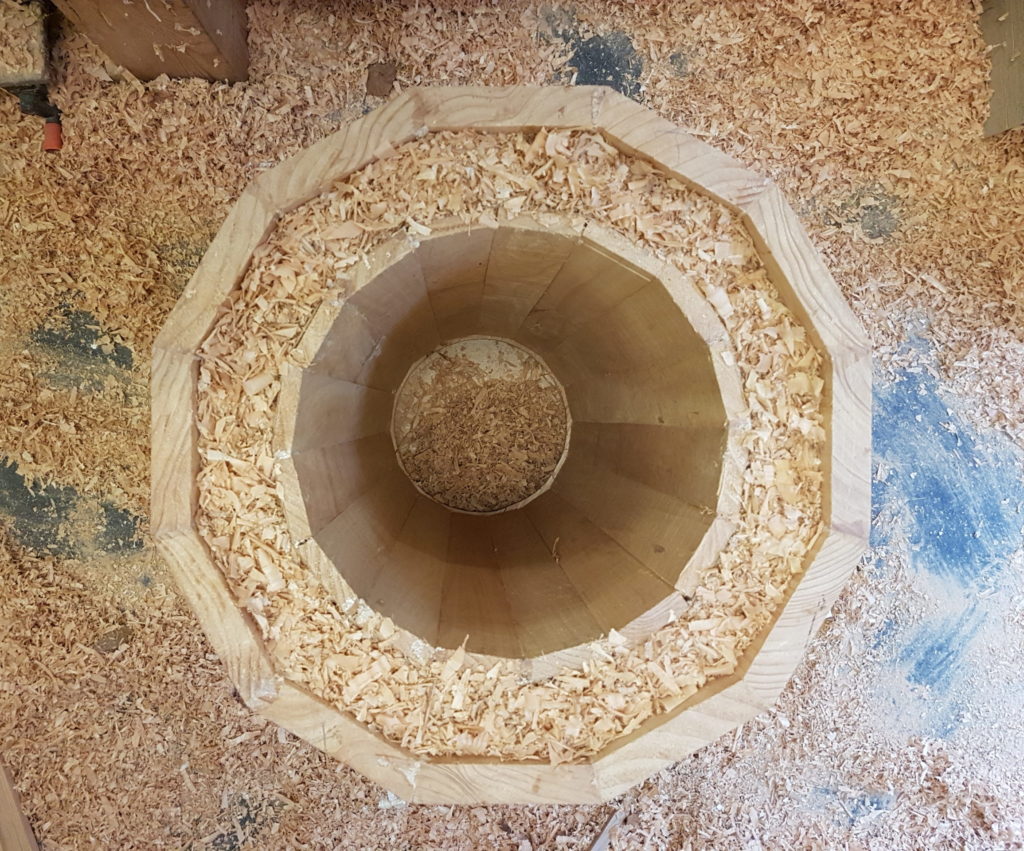
The freedom hive was designed by Matt Somerville and is based on a log hive. It consists of an inner cylindrical (or more accurately hexadecagon) cavity, some sort of insulation, and an outer wall (dodecagon). Unlike a log hive, it weighs only a fraction, yet achieves very good thermal insulation. The bottom cover is removable to allow for limited inspection and modest harvesting. They can be lifted into a tree, or propped up by stilts to a height which is favoured by bees (above 2m). It shares the advantages of log hives. Click for my Freedom hive project.
Horizontal unframed hives
Top bar or trough hive
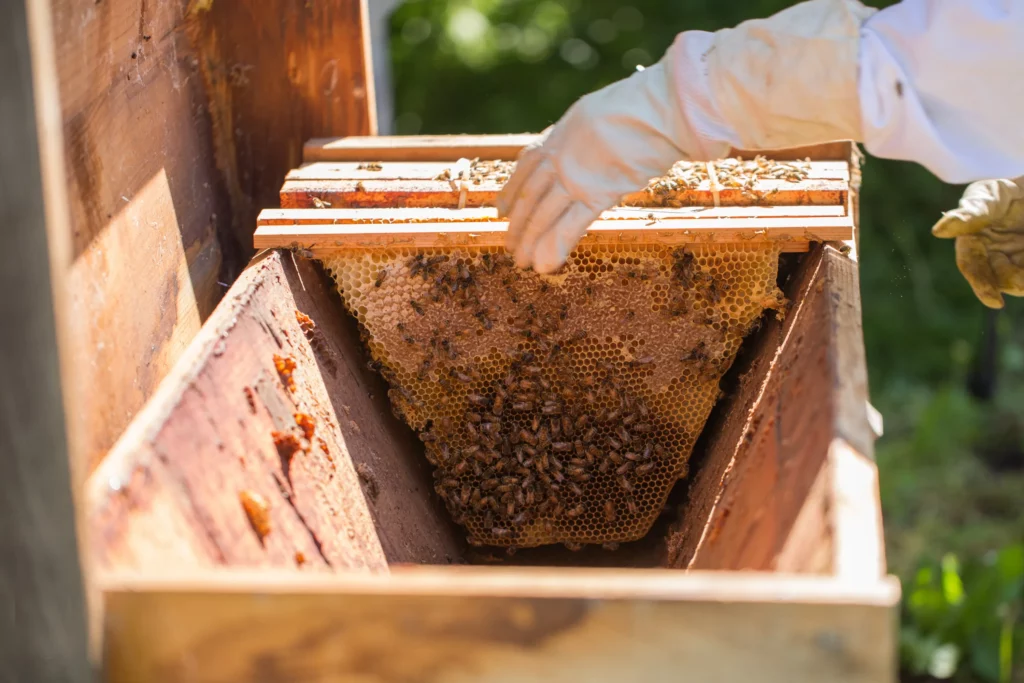
The top bar was already introduced earlier on in the paragraph about Warre hives. The top bar hive (TBH) therefore, could be considered somewhat a horizontal version of the Warre hive. It consists of a long tray with top bars, and a roof. The top bars themselves have a V-shape in their profile to act as guides for the bees to build comb. The size of the cavity is controlled using solid division or follower boards made in the same profile as the cavity in transverse section. This allows bees to build their own comb rather than using wax foundation sheets.
The TBH includes both the Kenyan and Tanzanian versions. They differ only in terms of the shape of the cavity. The Kenyan TBH has sloping walls whereas the Tanzanian has vertical walls. Theoretically, bees are less likely to build comb attaching to the sloping walls compared to the vertical walls.
Advantages
- Natural comb building
- No heavy lifting
- Easy to harvest
- Ability to inspect
Disadvantages
- No insulation built-in
- Requires some dexterity in handling comb due to risk of breaking
- Depth limits natural spatial distribution of comb
- Winter cluster of bees have to cross multiple combs to get to stores
An alternative to the normal top bar hive is the Cathedral hive. Instead of the normal straight top bars, the Cathedral hive has top bars which in continuity with the trough, form a beautiful hexagonal profile. This means that there is more surface area of comb per top bar and therefore better spatial distribution of brood and stores on comb. The top bars also contain holes in them which act as tunnels for bees to cross combs.
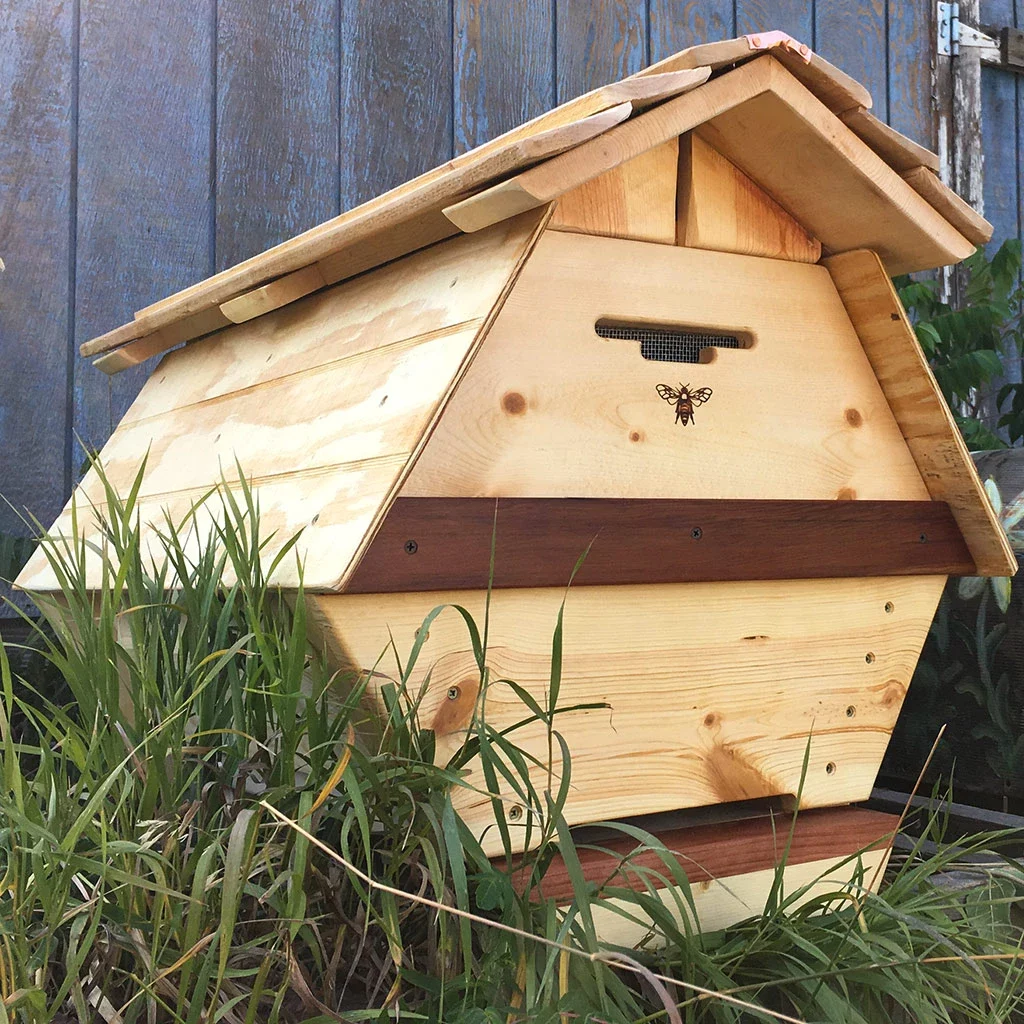
There is also a diagonal version of the cathedral hive, which is based on the fact that bees like to build comb downwards. However, one wonders with the technical skill required to construct such a hive, whether a log hive would have been more efficient.
Bienenkiste
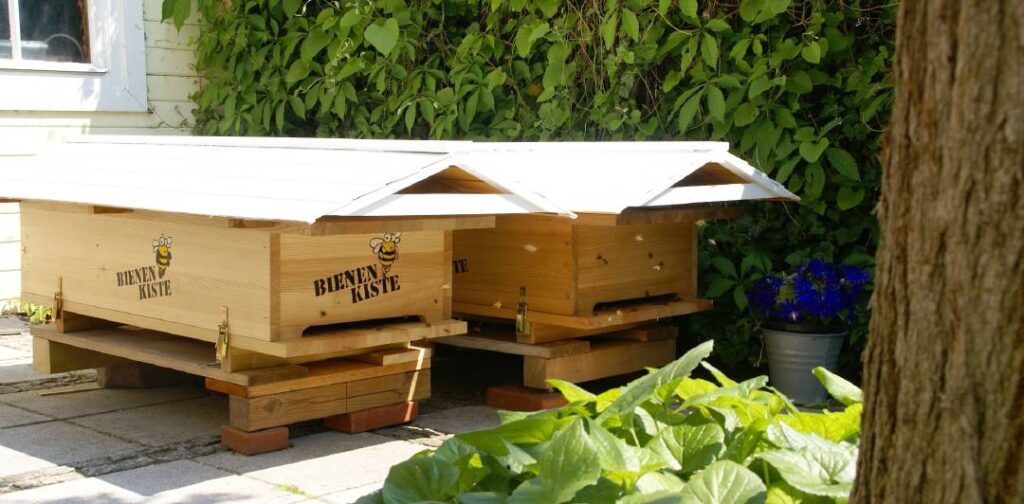
The German company Mellifera also produce their modification of a top bar hive called the Bienenkiste. They market it as a bee-friendly hive which can be inconspicuously put within a garden. The basic principle is that of a top bar hive. There are top bars which V-shaped profiles to help guide bees. There is also a small section which allows foundation strips to be used. This is supposedly the area for harvesting and treatment. The entire hive is essentially a flat box laid on the ground. However, there is a very sneaky twist to this. Hinges allow the top of the box to swivel upwards, exposing the entire colony to be inspected as a whole, at eye level. At first glance, it appears to strike a balance between being bee-friendly yet allowing inspections, some frames, ease of harvesting and treatment. However, there are several disadvantages. Firstly, it does not contain insulation, which makes wild temperature fluctuations likely (although not unlike most uninsulated hives). Secondly, evidence suggests that bees prefer a hive over 3m off the ground. The Bienenkiste instead puts them as close to the ground as possible. Not only does this afford little protection from other animals and insects, but depending on position of the hive, it may also cause the flight path of the bees to interfere with human activity nearby. Again this is not too unlike the positioning of most hives. Thirdly, while the top bars encourage natural comb building, the ability to expose the entire hive to the elements in a roller-coaster swivel fashion seems not only dramatically unnecessary, but perhaps even disrespectful of their space. Finally, there is a general critique about the history from which the Bienenkiste was developed. They cited historical hives which could be carried on the backs of beekeepers, who would then harvest and sell the honey at markets, or carry the hives to various locations for foraging. Because these historical hives existed in abundance, bees must have thrived in them. But this is perhaps an opposite interpretation, since the bees could well have survived despite being in such adverse conditions. Neverthless, the Bienenkiste exists as an easy-to-build, accessible and low-intervention hive with which to keep bees.
Conclusion
I have provided a summary of many of the hive used today. As mentioned this article is not meant to be exhaustive, nor as a substitute for your own research. Indeed, there are countless variations and modifications of even these hives. However, having a categorisation enables the mind to more easily draw similarities and differences between groups. It thus acts as a template, particularly for new beekeepers, to consider various philosophies, techniques and methodologies to explore this craft and cultivate their stewardship of these magnificent creatures.

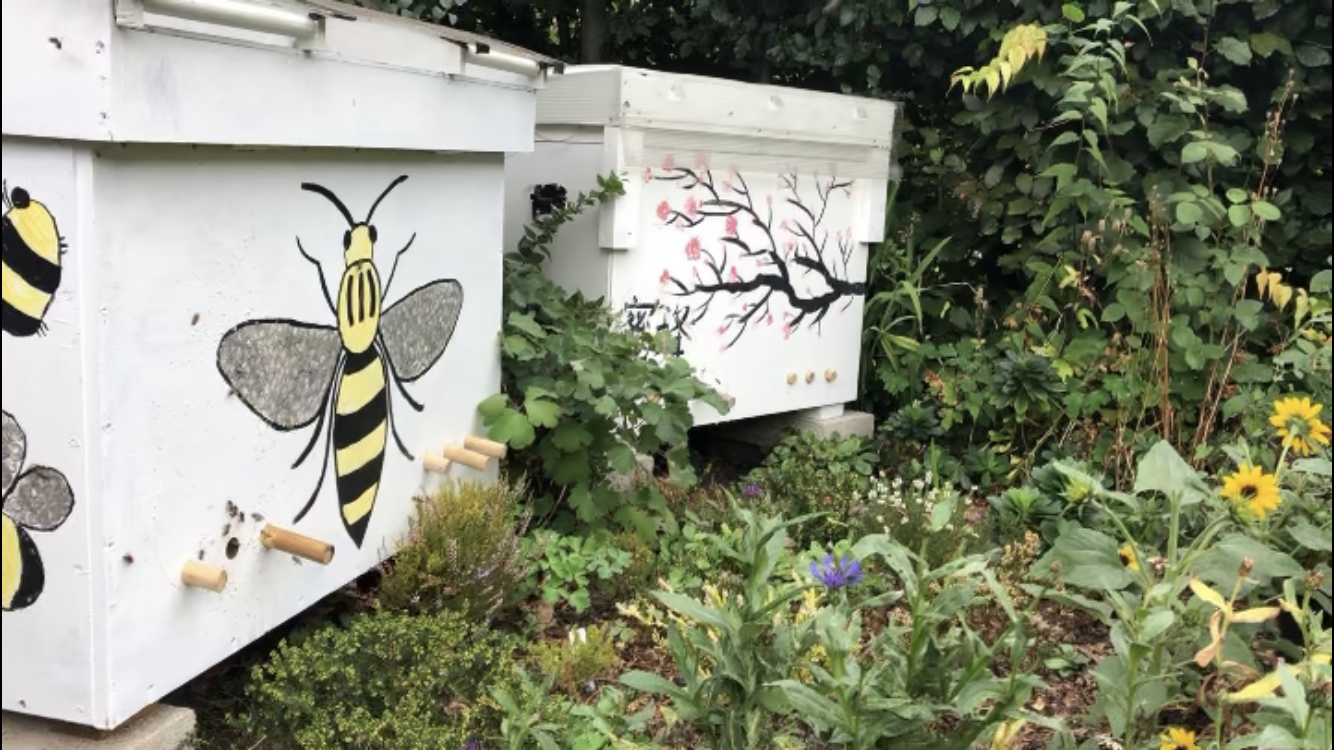
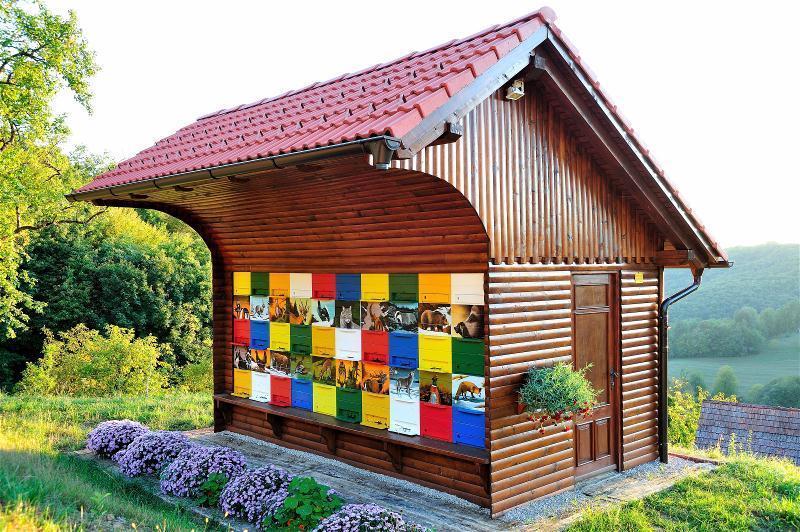
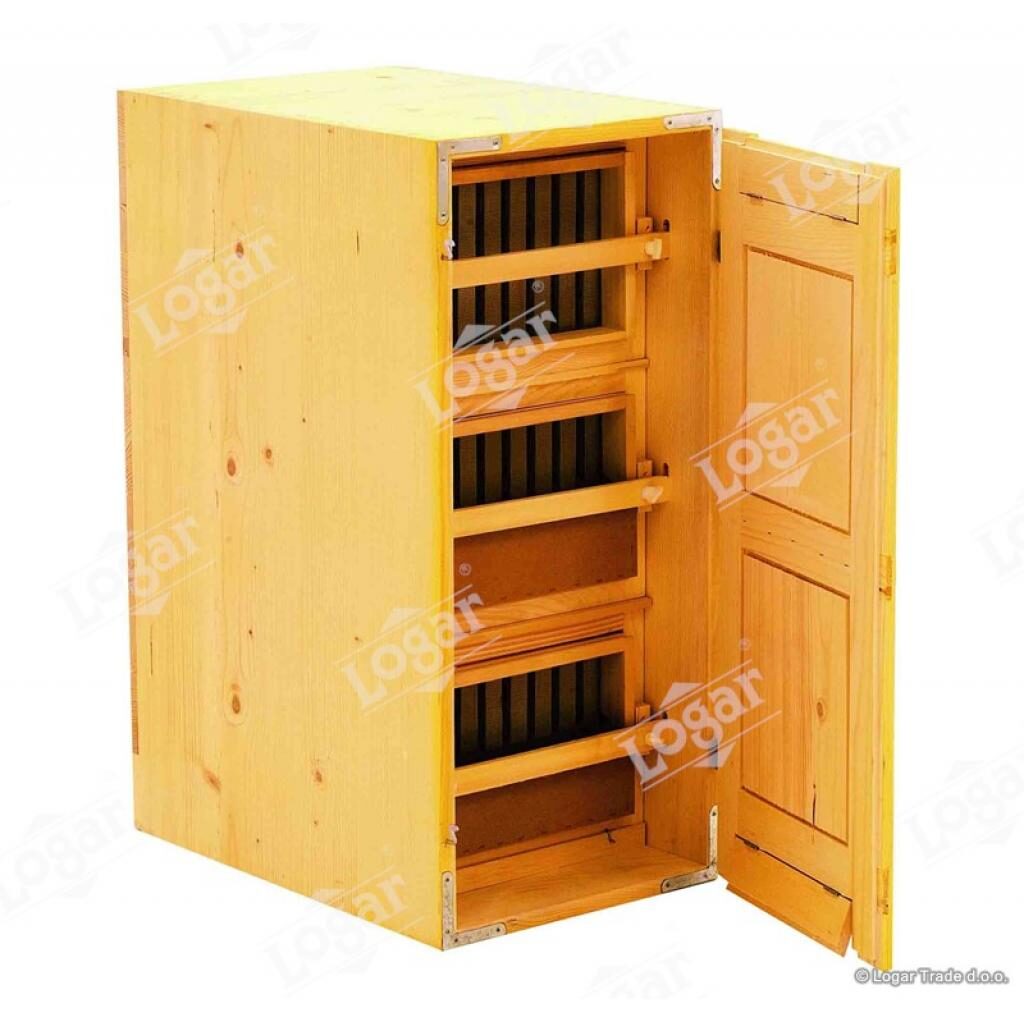
suggest including https://www.thezesthive.com/
Thanks Jade, I had forgotten about ZEST! Added it in now.
Thank you so very much.
I would like to build a horizontal framed hive and love that you have considered and included variations of advantages from different styles.
Can you please share building plans with dimensions? I really want to build but am stuck at the point of no plans for a hive that I want and without the experience to conjure one up.
If not for the hive you have, can you please share the plans that were the basis (your starting point), and describe the variations from there?
Very grateful Australian,
Jenny
Hi Jenny, thanks for reading and glad it was helpful. I don’t have strict dimensions, although referred to two websites for rough plans and modified from there. The first is David Heaf’s information: https://www.northernbeebooks.co.uk/products/the-modified-golden-hive-head/ or http://www.dheaf.plus.com/framebeekeeping/modified_golden_hive.htm
The second is Leo Sharashkin’s: https://horizontalhive.com/
There are various modifications from these dimensions, but the key measurement is the “bee space” of about 8mm on both sides of the frame to prevent bees from building comb between the frames and the inner hive walls. Otherwise, there is much room for modification. Hope that helps. I might write up my plans at some point of time if I get a chance.